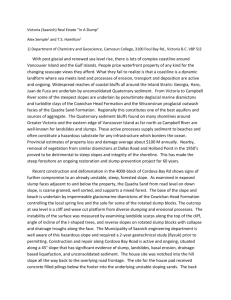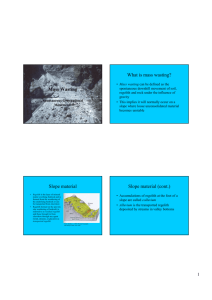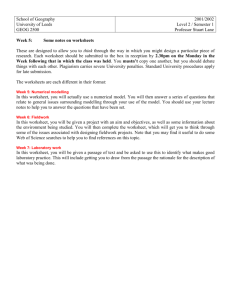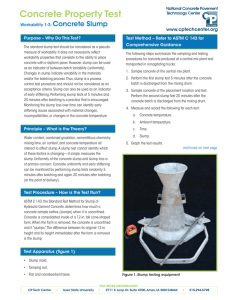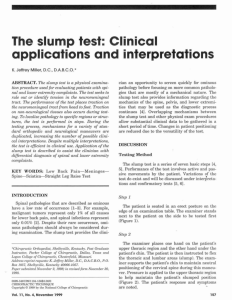Mass Wasting –Practice Questions and Answers
advertisement
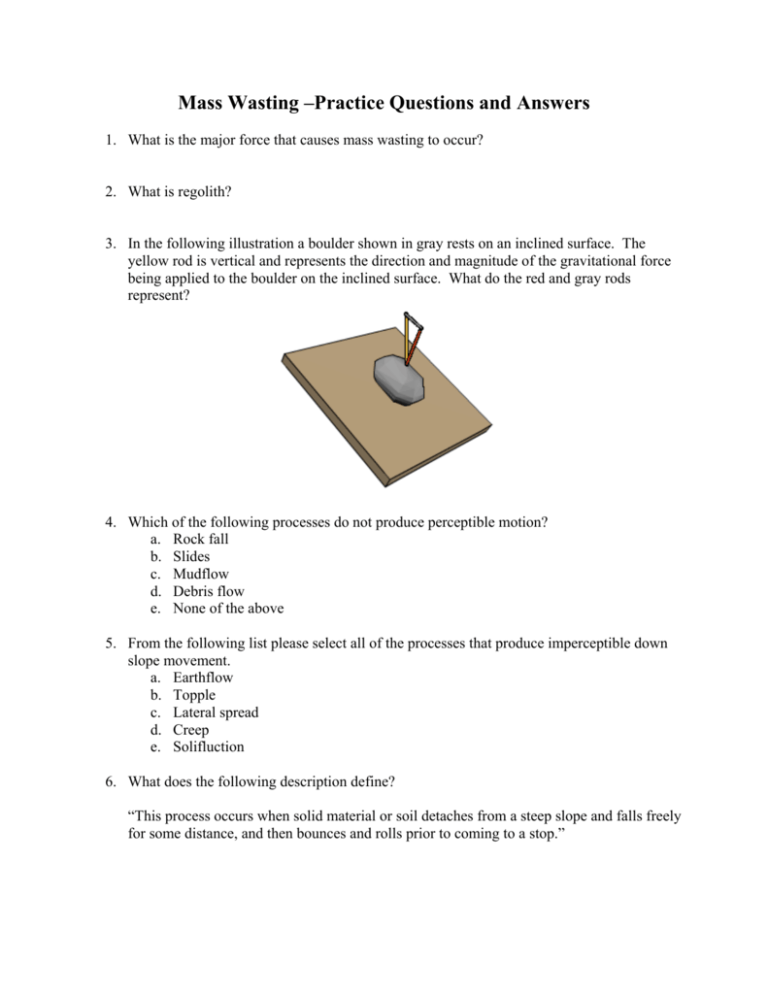
Mass Wasting –Practice Questions and Answers 1. What is the major force that causes mass wasting to occur? 2. What is regolith? 3. In the following illustration a boulder shown in gray rests on an inclined surface. The yellow rod is vertical and represents the direction and magnitude of the gravitational force being applied to the boulder on the inclined surface. What do the red and gray rods represent? 4. Which of the following processes do not produce perceptible motion? a. Rock fall b. Slides c. Mudflow d. Debris flow e. None of the above 5. From the following list please select all of the processes that produce imperceptible down slope movement. a. Earthflow b. Topple c. Lateral spread d. Creep e. Solifluction 6. What does the following description define? “This process occurs when solid material or soil detaches from a steep slope and falls freely for some distance, and then bounces and rolls prior to coming to a stop.” 7. Which of the following can produce the process described in question 6? a. Earthquakes b. Freezing and thawing c. Plant growth d. Rain e. None of the above 8. A _________________ is a rock fall where movement is initiated by the forwarding pivoting of the mass around an axis located in its lower part. 9. When a coherent mass of regolith or bedrock breaks free and then slides down slope along either a planar of curved surface, then it generates a a. b. c. d. e. Rock fall Earthflow Lateral spread Slump None of the above 10. If the coherent mass of regolith or bedrock described in question 9 slides along a relatively planar surface, then it is a ________________ slide. 11. If the coherent mass of regolith or bedrock described in question 9 detaches along a curved as opposed to a planar surface then the resulting slump is called ________________. 12. What does the following describe? “This type of slump is translational but consists of a single or a few closely related bedrock or regolith masses that moved down slope as a relatively coherent mass.” 13. What kind of slump is depicted in the following illustration? 14. What kind of slump is depicted in the following illustration? 15. Are earthflows coarser or finer grained than mudflows? 16. From the following list select the coarsest grained deposit generated directly from mass wasting? a. b. c. d. e. Earthflow Mudflow Debris flow Conglomerate Volcanic breccia 17. Select from the following list the necessary conditions to generate a lateral spread. a. Very steep slopes, solid highly fractured bedrock b. Very gentle or flat slopes, water saturated sediments overlain by more coherent clay or mudstones 18. What kind of flow is illustrated in the following diagram? 19. Which of the following processes commonly accompany the development of a lateral spread? a. Falling through the air b. Rolling and bouncing down slope c. Rotation along a curved surface d. Liquifaction e. Sliding down slope along a planar surface 20. Can you perceive the motion associated with creep and solifluction? 21. How would you distinguish creep from solifluction? 22. Can you list at least three reasons why the residents of Mount Soledad should not have been surprised when the October 3rd 2007 landslide occurred? Answers 1. Gravity – and specifically the tangential component of gravity 2. Regolith is all the material lying between unweathered rock below and the Earth’s surface. 3. The red rod is the normal component of gravity while the gray rod is the tangential component 4. They all produce perceptible motion, so the answer is none of the above 5. Creep and solifluction produce motion is so slow that that it is imperceptible to the human eye. 6. A rock fall 7. All of the listed processes/events can cause a rock fall 8. Topple 9. Slump 10. Translational slide – note slides and slumps are synonymous terms 11. Rotational slump (or slide) 12. A block slump (or slide) 13. The illustration depicts a translational slump 14. The illustration depicts a rotational slump 15. Earthflows are finer grained than mudflows. 16. From the provided list a debris flow is the coarsest deposit generated from mass wasting. 17. b. is the correct combination of setting and material to produce a lateral spread 18. The illustration is of a lateral spread 19. Liquifaction is a process common to lateral spreads. The answer is therefore d 20. No, these processes are characterized by imperceptible slow down-slope motion. 21. Solifluction is creep-like motion that occurs when the surface layer of permafrost melts creating a water-saturated mobile layer that moves slowly down slope. Creep is the general imperceptible slow and steady down slope movement of regolith. 22. There are a number of reasons why the residents of Mount Soledad should not have been surprised. These include (1) much of the area is underlain by a shale formation that is well known to be perceptible to landslides, (2) the geologic map of the area shows the locations of several ancient landslide deposits, (3) the area is transected by the Rose Canyon-Country Club fault system, and thus earthquakes along this fault system could generate a landslide, and (4) since 1961 there have been several landslides in the area.
